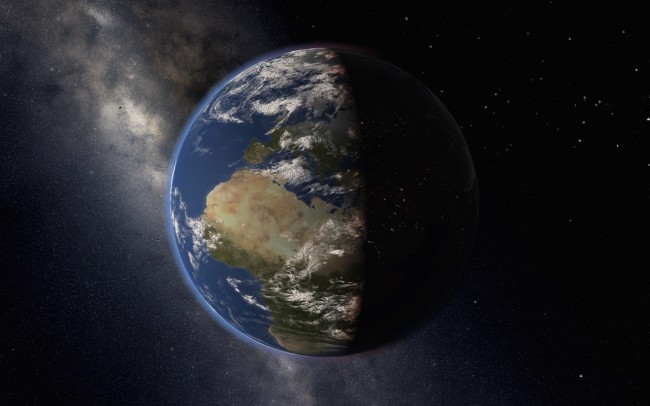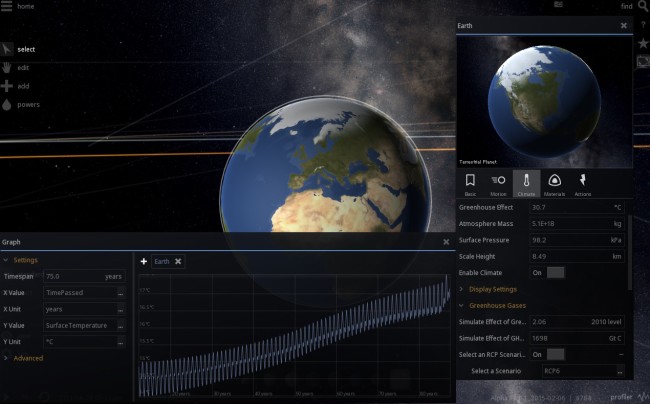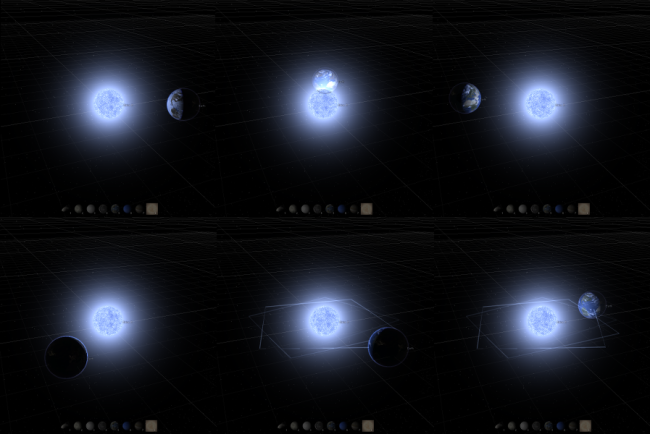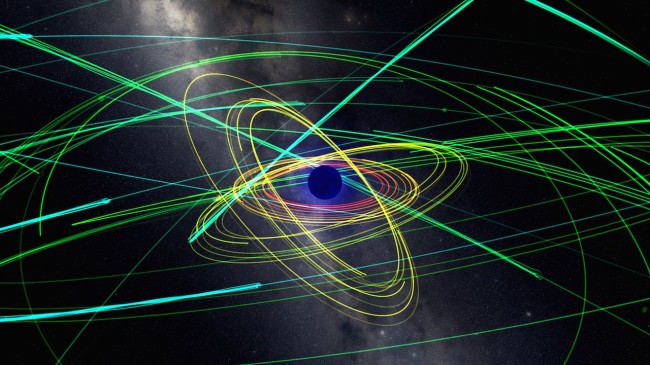Future Earth Climate Scenarios
Feb 20th
One of the most important features in Universe Sandbox ² is the ability to simulate Earth’s climate. It’s a relatively simple simulation, but it helps demonstrate exactly how fragile and ever-changing our climate is.
In Alpha 13, you can select possible future scenarios for Earth’s climate. These scenarios simulate the rise in carbon dioxide levels in Earth’s atmosphere caused by human activity up until the year 2100.
To simulate these, we use the same Representative Concentration Pathways used in the latest report from the Intergovernmental Panel on Climate Change (IPCC). These four pathways are projections for the future of greenhouse gas emissions and resulting concentrations in our atmosphere. You can see each pathway’s projections in the graphs below (left: emissions; right: concentration).

CO₂ emissions and associated concentrations generated from the RCP Database.
There are many factors we can consider when looking at what changes will affect emissions. Policies, land use, global population, our attitudes toward production and consumption — these can all have a huge impact on greenhouse gas emissions. Each RCP makes different assumptions about how and when these factors might change.
To stabilize concentrations, decreases in emissions are required, because even when emissions are lowered, CO₂ hangs around in the atmosphere for a long time.
Not only do the scenarios project different outcomes for concentrations, but, importantly, they each follow a unique trajectory based on a range of possible socio-economic changes. One assumes a peak in greenhouse gases in the next decade, while another assumes that there will never be stabilization. (This is simplified for the sake of this introduction; you can learn more here.)
In Universe Sandbox ², you can enable RCPs by selecting the Climate tab in Earth’s properties and toggling “Select an RCP Scenario.” The default is RCP 8 5. Click the (+) icon to select one of the other 4 scenarios.
Once enabled, the pathway’s concentration level will be tied to the simulation year. The change in net radiative energy balance is also specified by the scenarios, and we put that right into our energy balance as a decrease in outgoing infrared energy. This has the effect of increasing the greenhouse effect and ultimately increases the average temperature of the planet. To see how the different scenarios play out, you can graph Earth’s temperature over the course of several decades. Below is a simulation of RCP6 through 2100.
These pathways are not forecasts. But simulating them in Universe Sandbox ² can help you gain a more intuitive understanding of what is possible for the future of Earth’s climate.
Check out this blog post by Naomi, Universe Sandbox ²’s climate scientist, to learn more about how we simulate climate: Climate in Universe Sandbox ².
You can also check out the climate tutorials right in Universe Sandbox ²: Home -> Main -> Activities.
Physics Changes in Alpha 13
Feb 13th
A riddle: This feature is the biggest feature of Alpha 13, but it doesn’t draw a whole lot of attention to itself. In fact, when it’s working perfectly, you won’t even know it’s there. Without it, though, you’d be shaking your fist at the screen as you watch the whole solar system fall apart. What is it?
The physics rewrite of course! (Maybe the title of this post gave that away.)
While the collision overhaul part of the physics rewrite makes for some impressive visuals, perhaps more important is the addition of a new integration mode and the changes made to the way Universe Sandbox ² handles timestepping.
In short, orbits in Alpha 13 are much more stable, and capable of maintaining this stability even at very high timesteps.
An easy way of demonstrating this difference is to compare the behavior between Alpha 13.1 and Alpha 12 when adding Earth in orbit around Sirius B, a white dwarf that is similar in size to Earth.
Open a new simulation, add Sirius B, then add Earth close by. In Alpha 12, unless you drastically lower the timestep from the default of 1.3 hours per second, Earth quickly gets flung out of orbit.
You can see in the last screenshot above that Earth has shot off the screen. Somewhere, it is speeding off into the depths of space. This is certainly not what you expect when trying to put Earth into a simple orbit. But because of the high timestep and the relatively small orbital period, the simulation cannot calculate Earth’s position accurately enough to keep it in orbit.
This was a common problem in the original Universe Sandbox. Many users expressed their frustration when they’d run the standard solar system simulation, turn up the timestep, and watch as Mercury slingshotted out of its orbit and past Pluto. No, this is not what physics says should happen, but rather a computational limitation. In our FAQ for the original Universe Sandbox, we explained it like this:
- As you turn up the time step you lower the accuracy of the simulation. If the accuracy is too low, bodies will get thrown out of the system.
- The numbers: Mercury takes about 88 days to make a single orbit around the sun. A time step of 22 days would only be calculating a new position for Mercury 4 times in that period. This isn’t enough accuracy to maintain a stable orbit. The Earth is further out and takes 365 days to orbit the sun. This same time step of 22 days results in about 16 position calculations for the Earth which is enough to maintain an orbit.
Fortunately, Universe Sandbox ²’s numerical physics developer, Thomas, has spent a lot of time finding and implementing a solution to this problem.
Now, in Alpha 13.1, you can put Earth into orbit around Sirius B without worrying what the timestep is:
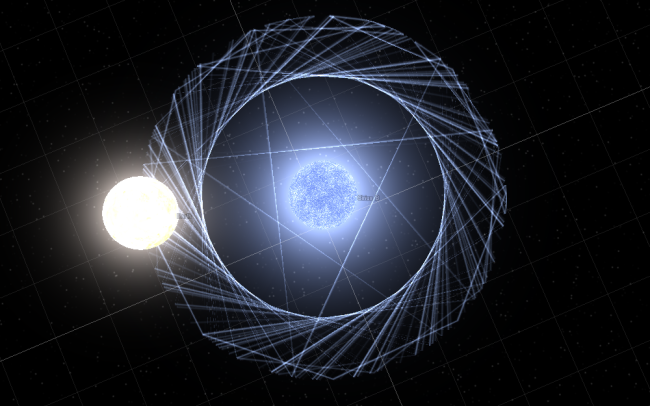
The new Global Adaptive integration mode will always take a safe step in order to maintain the accuracy as determined by the “tolerance” setting. Tolerance is the maximum amount of error that is allowed while taking a step when compared to perfect accuracy (which cannot run in realtime). This number will be much larger for simulations on the galaxy scale than simulations for dice and bowling balls, as the “acceptable” margin of error would be exponentially higher. You wouldn’t want your dice to take a million kilometer leap, but it’s probably okay for them to be off by a centimeter.
Tolerance can be manually adjusted in the settings, or you can let Universe Sandbox ² handle the adjustments. The tolerance is automatically set when loading a simulation to an amount that sufficiently maintains accuracy while also keeping the simulation running smoothly. It is also adjusted whenever a new body is added. We plan to add more automatic adjustments to respond to other simulation changes.
Finally, another large factor in determining stability is the actual numerical integrator that is used, with each having different strengths and weaknesses. For this, we can turn to a video that Thomas has created in order to explain some of the different integrators available in Universe Sandbox ².
https://www.youtube.com/watch?v=IJ2MhXUDZ6o
While the physics in Universe Sandbox ² is not perfect yet, we’ve made huge strides over the past year. Optimizations in terms of accuracy and performance are an ongoing process, and we look forward to continually improving the simulation.
Alpha 13 Now Available
Feb 6th
Alpha 13 is our biggest update yet.
Overhauled collisions, Mars climate, planetary cutaways, tidal heating and evolution, working orbital elements controls, a better looking UI, and much, much more.
Run Steam to update or buy Universe Sandbox ² now: universesandbox.com.
It’s our biggest update, and it’s also the update we’ve spent the most time on. A lot of this was due to the amount and complexity of the features we’ve been working on. But there were also quite a few unforeseen obstacles and bugs, and add to that some holiday time off… in short, it took us longer than expected. But now there’s plenty to explore, and we don’t think you’ll be disappointed.
In a previous blog post, we showed previews of planetary cutaways, Mars climate simulation, the collision rewrite, and radial velocity and light curves. These are big parts of Alpha 13, but there’s no need to repeat ourselves; let’s look at something new.
Alpha 13 introduces a vastly improved graphing tool. It now plots simulated time, autoscales and autoscrolls, and allows for customizable X and Y axes. You can view specific data by hovering your cursor, and you can easily add and change targets.
Combine that with the new climate feature that lets you simulate future greenhouse gas emission scenarios to get a clearer picture of what could be in store for Earth’s future. To learn more, run the Climate Scenarios activity in Home -> Main -> Activities.
In the screenshot above you can also see the new Milky Way background, the new font, and some new icons for the Properties window.
Also added to the UI is a list of icons at the bottom of the screen that show the bodies bound to the 1-8 number keys. Press 4 a few times to launch some moons at the Earth then turn on the new Body Colors mode for a colorful light show. With Body Colors, the colors of trails, bodies, and fragments are adjusted by mass, acceleration, or velocity.
The new collision system under the hood mean that these collisions will run faster and look better. Calculations have been improved for fragments, craters, momentum, temperature, and every other element of collisions.
The rewrite to physics also introduces a new Global Adaptive integration mode. This mode ensures that, at no matter the timestep, the simulation will retain an accuracy within a user-defined “tolerance” level. This keeps bodies on their proper paths, even when you’re running at thousands of years per second.
Check out our What’s New for a full list of new features, improvements, and fixes. It’s a long list.
We plan to return to a more regular update schedule for Alpha 14. Until then, there’s a lot for you to check out in Alpha 13.
Let us know what you think:
Multiple Languages in Universe Sandbox ²
Jan 26th
One of our goals is to make Universe Sandbox ² accessible to a wide range of users. No matter your age, scientific background, or experience with other simulators or video games, you should be able to pick up Universe Sandbox ² and let your curiosity drive your exploration of the universe.
One obstacle that may stand in the way is language. Right now, if English is not your first language, you may have a somewhat difficult time navigating Universe Sandbox ².
The good news is that we’re making progress on language localization. This makes it possible to switch on-the-fly between a bunch of languages beyond English. Right now we’re working on German and Danish, thanks to the native speakers on our team. Below is an early screenshot showing most of the UI text translated to German. (Note: we used Google Translate simply for demonstration purposes.)
Also on our shortlist is French and Spanish. After that, there’s no shortage of languages we’d like to support, including Russian, Chinese, Portuguese, etc. It’s possible we’ll open up the translation process to the public community at a future date.
If you do not yet own Universe Sandbox ², you can buy it now to get instant access to the alpha, as well as free updates up to and including the final release: universesandbox.com/2.
Watch a Demo of Atmospheric Scattering
Jan 23rd
In this video, Chad, our technical artist, demos his recent work on shaders which simulate atmospheric scattering (in real-time, of course).
Atmospheric scattering is a process in which particles in a planet’s atmosphere scatter sunlight. It is the reason why the sky is blue, and why the setting sun is red.
https://www.youtube.com/watch?v=6gfFPfgovoY
Please note: This video is a demo created by Chad; it is not from Universe Sandbox ². Atmospheric scattering is an experimental feature still in its early stages. Do not expect to see this implemented in an alpha release anytime too soon.
More information on atmospheric scattering:
If you do not yet own Universe Sandbox ², you can buy it now to get instant access to the alpha, as well as free updates up to and including the final release: universesandbox.com/2.
Black Hole Rings in Universe Sandbox ²
Jan 13th
Have you seen Interstellar? Without revealing too much of the plot… the sci-fi film follows a group of astronauts who search the depths of space in hopes of finding a new home for the human race.
The film’s special effects team worked with astrophysicist Kip Thorne in order to create visual effects that were not only beautiful representations of our universe, but were also founded on accurate science (Wired article).
One phenomenon they wanted to simulate was a massive black hole with an accretion disk. What they ended up with is certainly impressive: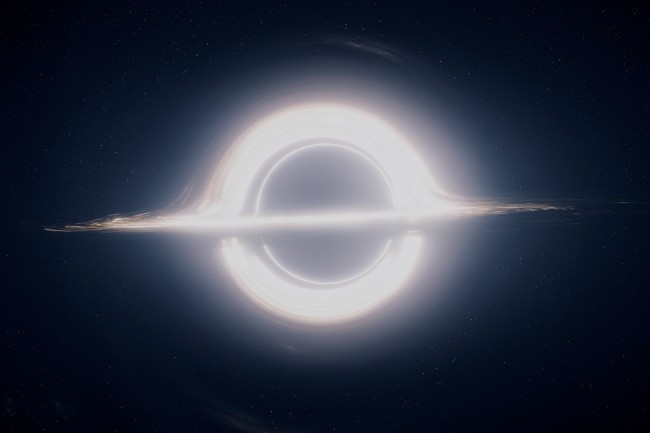
Turns out, if you add rings to a black hole in Universe Sandbox ², you get something that looks pretty similar:
Of course, you’ll notice a few differences between these images. But that might be because the first image is from a pre-rendered animation made for a film with a $165 million budget, and the second is from a real-time, interactive simulation that can run on your home computer.
If you don’t yet own Universe Sandbox ², buy it now to get instant access to the Alpha through Steam as well as free updates up to and including the final release: universesandbox.com/2
Watch a Demo of Exoplanet Detection in Universe Sandbox ²
Dec 9th
The video below was created by Eric, an astronomer working on Universe Sandbox ².
He explains how we calculate both radial velocity and normalized light curves, two key components in methods of detecting exoplanets.
You will be able to try out these new features for yourself in an upcoming alpha of Universe Sandbox ².
If you do not yet own Universe Sandbox ², you can buy it now to get instant access to the alpha, as well as free updates up to and including the final release: universesandbox.com/2.
Hiring a Planetary Scientist
Dec 3rd
This position has been filled. Thank you to everyone who applied.
If this still sounds like an ideal job for you, please reach out. We are always looking for more help from the right candidates.
Giant Army is looking for a planetary scientist or astronomer with a strong scientific computing background to join our team. You should be interested in helping us extend, improve, and develop the physical simulations at the heart of Universe Sandbox ². This is a contract position, but has the potential to become more permanent.
You will work closely with Giant Army’s current astronomer, as well as the creator of Universe Sandbox, in addition to our climate scientist, core game architect, numerical physics developer, graphics programmer, and technical artist.
Join us… we’re making something incredible that’s never been done before.

Your Role
- Help design, improve, and code the real-time simulation, which merges the gravity simulator with other simulated systems and incorporates as much realistic science as possible
- Help discover simulation edge cases and develop solutions to solve them
- Advise the team on how to best make the simulation, data, and visuals more realistic
- Some potential areas for development include connecting composition and physical properties, gas giant atmospheres, habitability, major impact aftermath, and your favorite project.
Ideal Candidate
- Loves physics simulations and fantastical what-if scenarios: https://what-if.xkcd.com/
- Is a self-driven and talented programmer with experience developing numerical models in a compiled language using modern developer best-practices
- Writes clean code that is comprehensible to teammates
- Is excited about developing a tool that allows users to experiment with simulations, pushing the boundaries of what has been done in real-time for public consumption
- Can envision what makes the best interactive experience with physical concepts, and how best to crunch the numbers to make it happen
Mandatory Qualifications
- Planetary science || (astronomy && (physics || chemistry)) background
- Simulation design and coding experience
- Strong enthusiasm for using models to explore both realistic and fantastical what-if scenarios
- Strong interest in helping change the way the world perceives our universe and fragile planet
- Good communication skills and proficiency in English, both writing and speaking
Preferred Qualifications
- (Strong C# && Unity Engine experience) || (Experience with an entity component model && object-oriented programing)
- M.S. or PhD in relevant field
- Ability to meet in person at least once a month in Seattle, WA, United States, but will consider outstanding candidates from anywhere in the world
Company Overview
Giant Army is the company behind Universe Sandbox, a space simulator that’s sold hundreds of thousands of copies on Steam. Our headquarters are in Seattle, Washington, USA, with team members in Montana, Florida, Germany, and Denmark.
Team members enjoy a flexible, collaborative environment. We strive for work-life balance, and we pursue the features that get us excited about science. We do the work so that we can share that with others. We’re also committed to creating an accessible experience that can’t be found elsewhere.
Science is for everyone, and we welcome all qualified applicants.
Product Overview
Universe Sandbox ² is our core product that lets the user explore and learn about our amazing universe and fragile planet while creating and destroying on a scale they’ve never before imagined. It’s more than a game; it’s a way of experiencing and learning about reality in a way that’s never been done before. Early alpha access now available for Windows, Mac, and Linux.
How to Apply
This position has been filled. Thank you to everyone who applied.
If this still sounds like an ideal job for you, please reach out. We are always looking for more help from the right candidates.
Email us: jobs at universesandbox.com
In the email please include:
- Relevant email subject
- Link to or copy of your resume or CV
- Answer to these two questions:
– What is the most appealing part of this opportunity?
– What feature would you be most interested in adding or helping make better? - Where you originally heard about this job posting
Alpha 13 Preview
Dec 1st
Alpha 13 is just around the corner.
Here are a few of the features we’re excited to introduce in this next update:
1. Planetary Cutaways
Cutaways can now be seen for any planetary body, which offers a nice visual representation of its material composition. Below you can see the cutaway for Jupiter’s moon, Europa.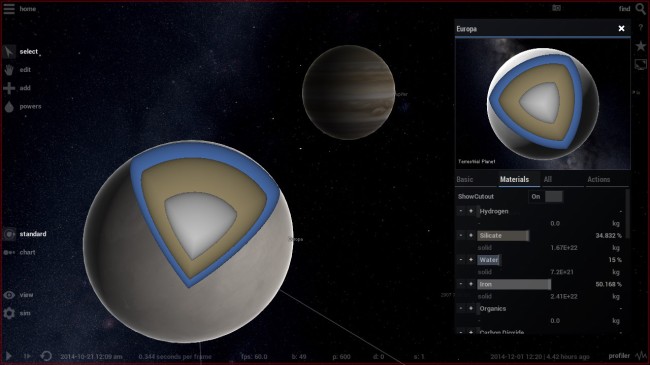
2. Mars Climate Simulation
Our climate scientist has been working on expanding the climate model beyond Earth. Mars brings a whole new set of challenges. It’s not just a matter of plugging in Mars’s values into the existing calculations; there are fundamental differences which change the basic parameters of the model. For example, unlike Earth, so much carbon dioxide in Mars’ atmosphere freezes out every year that the atmospheric pressure drops and rises seasonally.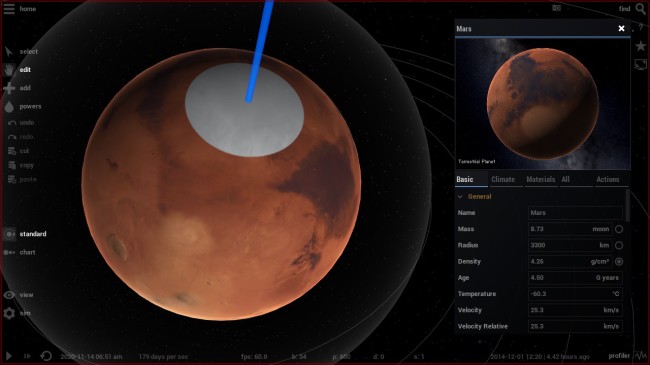
3. Collision Rewrite
Major improvements to the underlying physics will bring performance boosts and better collisions more of the time, as well as pave the way for some future improvements and features. Take a look behind the scenes of collisions in Universe Sandbox ² in the video below, made by Thomas, our numerical physicist.
4. Radial Velocity & Light Curves
It’s now possible to graph both radial velocity and simulated light curves, two key components in methods used for detecting exoplanets. 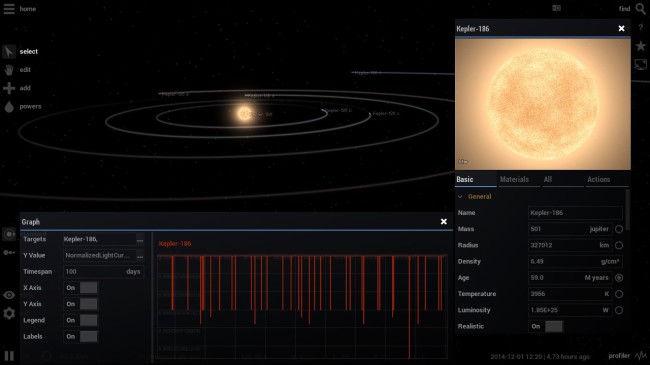
And we have a few more updates and fixes in the works.
We will post an announcement on the forum when Alpha 13 is available in Universe Sandbox ² Alpha Discussion. Steam will automatically download the update.
If you do not already own Universe Sandbox ², you can buy it now to get instant access to the alpha and receive free updates up to and including the final release.
Interviews From PAX Prime 2014
Nov 21st
PAX Prime 2014 is long gone now, but we thought we’d share with you these interviews with Dan, creator and lead on Universe Sandbox ², in case you didn’t catch them back in September.
In the backgrounds of these videos from TimmyTechTV and GeekGamer.TV, you can see our booth and demos of Alpha 10 of Universe Sandbox ².
https://www.youtube.com/watch?v=Te3T-xvkLeQ
GeekGamer.TV’s YouTube Channel
We are now up to Alpha 12.1 of Universe Sandbox ².
Buy it now to get instant access to the Alpha through Steam as well as free updates up to and including the final release: universesandbox.com/2

